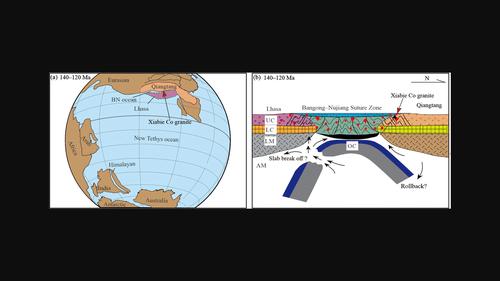当前位置:
X-MOL 学术
›
Acta Geol. Sinica Engl. Ed.
›
论文详情
Our official English website, www.x-mol.net, welcomes your feedback! (Note: you will need to create a separate account there.)
Petrogenesis of an Early Cretaceous Xiabie Co I-type Granite in Southern Qiangtang, Tibet: Evidence from Geochemistry, Geochronology, Rb-Sr, Sm-Nd, Lu-Hf and Pb isotopes
Acta Geologica Sinica-English Edition ( IF 3.3 ) Pub Date : 2021-06-21 , DOI: 10.1111/1755-6724.14777 Hong LIU 1, 2 , Hanxiao HUANG 2 , Guangming LI 2 , Wenchang LI 2 , Youguo LI 1 , Dongfang MA 2 , Yong HUANG 2 , Qing ZHOU 2 , Jiangang FU 2
Acta Geologica Sinica-English Edition ( IF 3.3 ) Pub Date : 2021-06-21 , DOI: 10.1111/1755-6724.14777 Hong LIU 1, 2 , Hanxiao HUANG 2 , Guangming LI 2 , Wenchang LI 2 , Youguo LI 1 , Dongfang MA 2 , Yong HUANG 2 , Qing ZHOU 2 , Jiangang FU 2
Affiliation

|
Cretaceous magmatism is widely distributed on both sides of the Bangong–Nujiang suture zone (BNSZ). These rocks record the subduction to closure history of the Bangong–Nujiang Tethys Ocean (BNO) and the collisional history between the Lhasa (LS) and Qiangtang (QT) terranes. The Xiabie Co granite in Nyima County, which located on the southern margin of the QT terrane, Tibet. In this study, whole-rock geochemistry; Rb-Sr, Sm-Nd, and Pb isotopes; and laser ablation inductively coupled mass spectrometry (LA-ICP-MS) zircon U-Pb ages and Lu-Hf isotopes of the Xiabie Co granite in the Nyima area have been studied to constrain its petrogenesis and tectonic setting. Our study can help explain the tectonic evolution of the BNSZ and crust-mantle interaction. Zircon U-Pb dating indicates that the granite was emplaced at ca. 120 Ma. The granite contains a small amount of hornblende and has high silicon (SiO2 = 73.97–78.03 wt%), potassium (K2O = 4.75–6.53 wt%), and total alkali (K2O + Na2O = 7.98–8.98 wt%) contents; low calcium content (CaO = 2.33–4.11 wt%); and variable A/CNK (1.00–1.18) and A/NK (1.09–1.22) values. The P2O5 content of the granite negatively correlated with the SiO2 content. Thus, the Xiabie Co granite is a weakly peraluminous I-type granite belonging to the high-K calc-alkaline to Shoshone series. It is enriched in light rare earth elements (LREEs) and relatively depleted in heavy rare earth elements (HREEs), with LREE/HREE ratios of 8.03–16.40 and LaN/YbN ratios of 10.2–27.1. Samples show right-leaning chondrite-normalized rare earth element patterns with pronounced negative Eu anomalies (Eu/Eu∗ = 0.67–0.76). The primitive-mantle-normalized trace element spider diagrams of the samples are right-leaning zigzag curves, showing relative enrichment in large-ion lithophile elements (LILEs, e.g., Rb, Th, U, and K) and depletion in high-field-strength elements (HFSEs, e.g., Nb, P, Ti, and Yb) and displaying striking Sr and Ba negative anomalies. The granite εHf(t) values were positive (2.9–9.9), whereas the whole-rock εNd(t) values were negative (–2.841 to –2.33). The calculated (87Sr/86Sr)t, (206Pb/204Pb)t, (207Pb/204Pb)t, and (208Pb/204Pb)t values are 0.7014–0.7057 (0.7044 on average), 18.422–18.851 (18.670 on average), 15.625–15.642 (15.633 on average), and 38.332–38.681 (39.571 on average), respectively. On the basis of the aforementioned data, we propose that the Xiabie Co granite was derived from a primitive magma that originated from partial melting of juvenile lower crust with the addition of mantle materials. In addition, strong fractional crystallization occurred during the rock-forming process. Given the geodynamic setting, our new data, together with previously reported achievements, imply that the Xiabie Co granite was formed during the LS–QT collision.
更新日期:2021-06-21



























 京公网安备 11010802027423号
京公网安备 11010802027423号